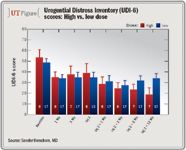Article
Autologous muscle-derived cells show efficacy, safety in SUI
Injections of autologous muscle-derived cells appear to be both safe and effective in the treatment of stress urinary incontinence, with a trend toward greater effectiveness at higher doses.
St. Petersburg, FL-Injections of autologous muscle-derived cells (AMDC) appear to be both safe and effective in the treatment of stress urinary incontinence, with a trend toward greater effectiveness at higher doses, say the authors of a Canadian study.

Among 23 patients who had reached 12-month follow-up and had received two injections, 10 (43%) reported no stress leaks since the second injection. The number of stress leaks experienced over a 3-day period fell by ≥50% in 16 (70%) of them.

In addition to positive objective responses, patients also had improved quality of life scores on the short forms of the Incontinence Impact Questionnaire and Urogenital Distress Inventory scales 12 months after undergoing treatment.
Of the three patients who received only a single injection, all reported improvements of ≥50% in stress leaks.
Improvements of ≥50% seen
"I believe most of the patients who opted for a second injection did so because they could," Dr. Herschorn said. "Those who were experiencing positive effects wanted a second treatment to see if they could have further improvements. And those who did not respond thought a second treatment would help improve their condition.
"In many cases, the decision to have a second treatment was made within 2 months of the initial therapy, which may not represent enough time for the first injection to have a chance to work."
Indeed, Dr. Herschorn identified AMDC therapy's potentially prolonged processing time as "a potential drawback," since treatments may take 3 to 6 months to reach a maximal response. In any case, he noted, the goal "is to identify a dose that provides symptom relief with only one treatment."
All patients in the study received cystoscope-assisted periurethral injections and were allowed to elect a second injection of the same dose after 3-month follow-up. Follow-up occurred at 1, 3, 6, and 12 months after the last injection. Mean age of the 29 women was 49.5 years (range, 36-73 years).
Patients experienced no serious adverse events from the treatment. Minor events included pain and bruising at the muscle biopsy site, mild local reactions to cell injection, mild self-limited urinary retention, and urinary tract infection. One patient reported worsened incontinence after the second injection.
Dr. Herschorn's group will continue its work in determining an optimal treatment range by examining a smaller range of cell doses. After that, they're looking to conduct a double-blind, randomized, placebo-controlled trial designed to prove efficacy.
Cook Medical, Inc. sponsored the current trial.
Newsletter
Stay current with the latest urology news and practice-changing insights — sign up now for the essential updates every urologist needs.















